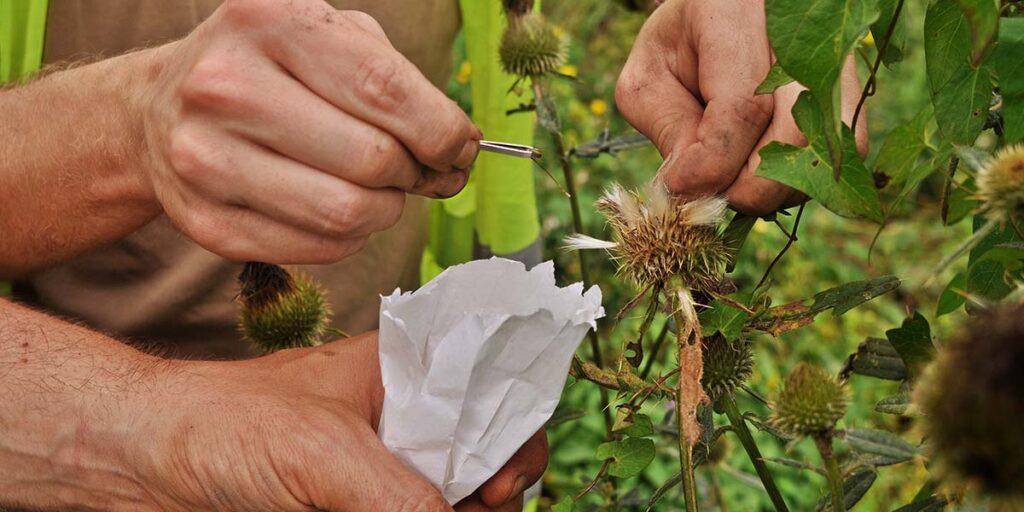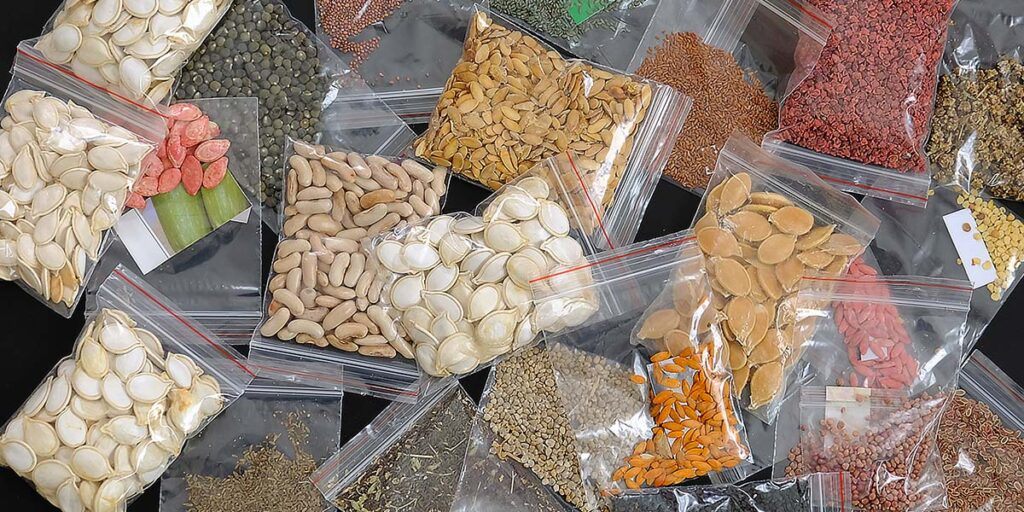
By Angelo Randaci, Earth’s Ally Horticulturist
Angelo’s passion for plants has led him to explore many areas of horticulture including research, grounds management, technical training, design and nursery management.
Seed Saving Primer
My first experience of seed saving was my early years of gardening with my father. My Dad was from Sicily where most people grew much of their own food and used flowers to splash colors across the neighborhoods. He saved seeds from his marigolds, zinnias, impatiens, foxgloves, columbines, and Italian basil. Herbs and rare veggies were a large portion of the garden. We used every plant in the garden to either flavor food, eat as the main course or bring color and life to our yard. My Dad saved the seeds of a special variety of sauce making heirloom tomatoes his mother sent from Italy, and we ate the delicious sauce made from those tomatoes all winter long. We used a small room in our basement where we kept each year’s seed crop safe, dry, and cool.
Many plants will self-seed naturally so collecting and saving seeds needs a bit of special care if you wish to maintain purity of any certain variety. The following is a beginner’s guide to seed saving; terms, collecting, storage and plenty of tips to help you.
Why Save Garden Seeds?
Old garden variety heirloom plants are often difficult to find and saving seeds is a way to preserve a variety. Many plants available one year, may disappear the next. Saving seeds of your favorite varieties will offer a steady supply of useful seeds.
If you need a large quantity of plants, collecting seeds will save money as opposed to buying individual plants. If you want to incorporate 20 foxglove plants into your garden, buying 20 plants can be costly when compared to collecting seeds from one of your established plants. Seeds saved from your garden plants will be better adapted to your own growing conditions. And it’s fun because you can get into cross pollination of your favorite flowers to develop different colors and forms.
Open Pollinated vs. Hybrids
To understand what and when of saving seeds, let’s begin with the two categories of plants. Open pollinated (also called heir loom or self-pollinated) and hybrids.
- Open pollinated plants: Open pollinated plants are those pollinated by insects, birds, wind, etc. or human hands. They will grow true from seed, and seedlings will be exact replicas of their parents. Examples include heirloom tomatoes, beans, peas, and other vegetables as well as an assortment of flowering plants such as foxgloves, sweet Williams, marigolds, and many others. Open-pollinated plants can and often do, cross-pollinate with other members of their species by wind or insects. When this happens, you may lose your original open-pollinated variety. It is possible to obtain different colors or forms, but seeds may or may not grow identical to the parent plants.
- Hybrids: Seeds from hybridized plants, unlike open-pollinated plants may share characteristics of either or both parents and will not come true from collected seeds. To maintain an exact clone of a hybrid, you would need to propagate hybrid plants from cuttings, or purchase seed every year.

Collecting Seeds
Be sure to collect seeds from the healthiest plants in your garden. If you are looking to improve certain traits such as biggest fruits, collect seeds from the biggest fruits. The same is true for other traits you wish to see improved such as disease resistance, color, form, habit, and size. Collect seeds with the desirable attributes when they are viable. This means they need to be fully ripened, or they may not germinate. The optimal time to collect seeds is most often after the plant has flowered or produced fruits and the seeds are left to fully mature. By this time, the original plants have finished their growing cycle for the season. Seeds that grow in pods are not ready to collect until the pods turn brown and begin to split open. Harvest marigold seeds when the flowers dry out on the plants. Seeds of corn should dry on their cobs while still in the garden. Always check for specific time-table instructions for each variety you are interested in collecting.

Long Term Seed Storage
Seeds must be dry to avoid mold during storage. Extract any seeds enveloped in pulp, spread them out on screens, and provide air flow to hasten the process. Seeds of marigolds and zinnias can be removed from their spent flowers and placed in a paper bag in a cool dark place. Don’t forget to label your seed storage containers.
Helpful Tips for Seed Saving
- Plants that self-seed such as columbines, forget-me-nots, and sweet Williams will germinate in the soil near the parent plants. They can easily be transplanted from one spot and moved to another or let them naturalize throughout the garden. No seed saving is necessary in this case.
- Collecting seeds from zinnias and marigolds are among the easiest to collect and germinate. They are great for beginners as well as peas and beans.
- Share your seeds with other gardeners, neighbors, and friends. Seed exchanges can be a fun social event.
- Be sure to incorporate pollinator plants in your garden. You can easily obtain a list of pollinator plants for your area.
- If you are a beginner, keep it simple by planting one variety per species. This is a good way to avoid cross-pollination.
- Know how pollination occurs of different plants. Some plants are called “selfers” and they will self-pollinate before the flowers open and limit success with cross-pollination. Some are pollinated by insects and others are wind pollinated.
- Become acquainted with botanical names; genus, and species of the plants you grow. This will help you avoid cross-pollination between two different varieties within the same species. Some species of plants will cross-pollinate, and some will not. A little research will go a long way. Know if you are growing an annual, biennial or perennial. Biennials, for instance may not set seeds until their second year of growth.
Tips for Cross Pollinated Plants:
- Plant only one variety of a species. If you are planting different varieties, they will need to be separated by distance. Planting one variety separated by another may provide enough distance to avoid cross pollination.
- Separate one variety from another by using a physical barrier. A row cover can be used to avoid cross pollination. Cover one variety and allow enough time for pollination of the other variety. Then repeat the process with the covered variety.
We’d love to hear how Earth’s Ally is helping you grow healthy, organic gardens. Share your experience and stay connected with the #EarthsAlly community on Facebook, Instagram and Twitter for access to our latest blog posts, giveaways and exclusive promotions.
